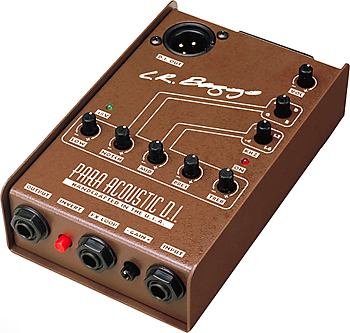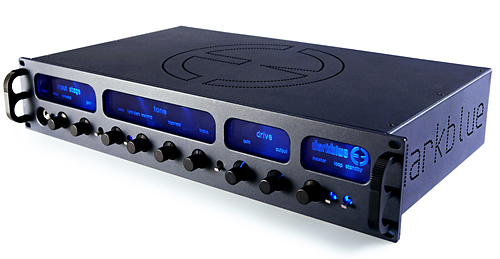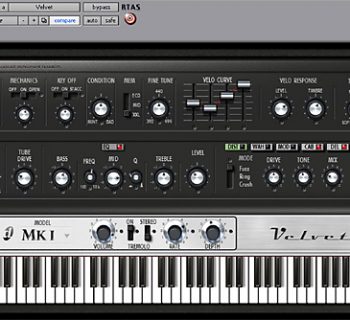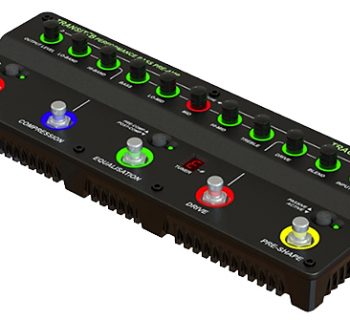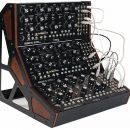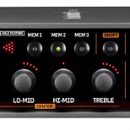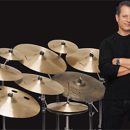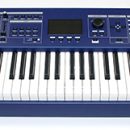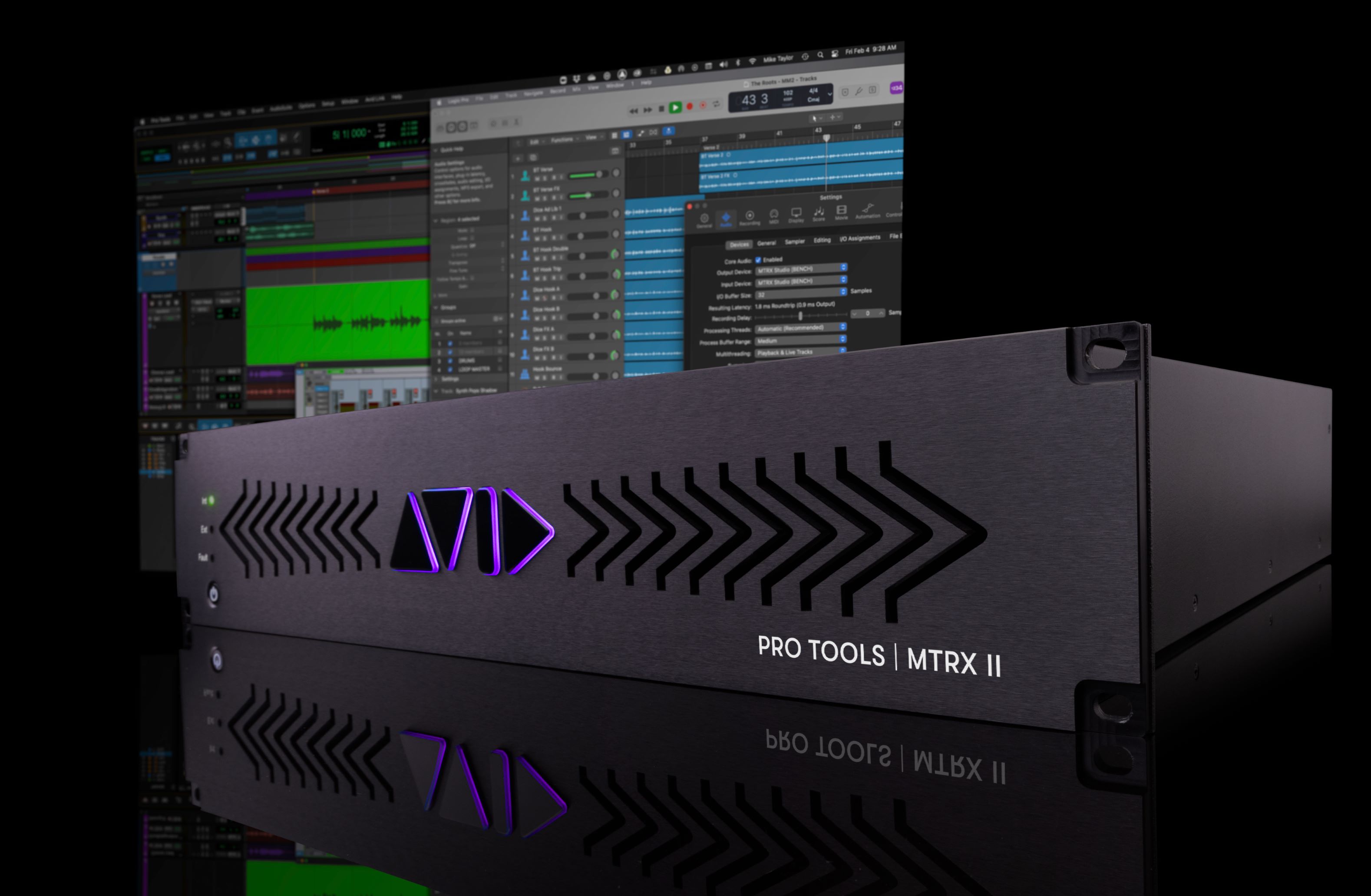 Replicating the pure beauty of sound from an acoustic guitar has always been a challenge for both studio and live technicians alike. In the absence of dedicated acoustic guitar amplifiers, direct boxes are a necessity for getting a strong signal from your guitar to the mixing board.
Replicating the pure beauty of sound from an acoustic guitar has always been a challenge for both studio and live technicians alike. In the absence of dedicated acoustic guitar amplifiers, direct boxes are a necessity for getting a strong signal from your guitar to the mixing board.
As seen with most generic direct boxes on the market, though, functionality and control are typically limited. Not so with the L.R. Baggs Para Acoustic D.I. – a direct box of unrivaled sonic character. Thanks to its variety of functional controls and exemplary tone quality, it brings a breath of fresh air to the world of otherwise boring D.I. boxes. The tonal enhancement for guitars running through a P.A. system – particularly Piezo-pickup equipped solid-body guitars, was so good that the Para Acoustic D.I. rendered our need for a dedicated acoustic guitar amplifier virtually unnecessary.
| Category | Value | Rating |
| Features | 20% | |
| Usability | 25% | |
| Sound | 25% | |
| Documentation & Support | 10% | |
| Price | 20% | |
| OVERALL RATING = 3.7, which earns it a WIHO Award. 3.6 stars or better: Outstanding, WIHO Award 3 stars or better: Worth considering 2 stars or better: Suited to specific needs 1 star or less: Not recommended |
||
We found the L.R. Baggs Para Acoustic D.I. to be an essential enhancement to any acoustic pickup configuration. A full complement of control features including a notch filter, sweepable EQ, and an effects loop, all ensured that a fantastic acoustic sound could be obtained. The only question left in our minds is how did we live for so long without owning one?
Features
The L.R. Baggs Para Acoustic D.I. surpasses most (if not all) direct boxes when it comes to onboard features and flexibility. Contributing to its versatility and ability to enhance any acoustic pickup configuration is a five-band EQ including Bass, Treble and Presence controls, a tunable Notch filter, and sweepable two-octave Midrange control.
The Notch control and Tune knob are designed to dial in and eliminate any feedback caused by frequencies between 98Hz – 247Hz, typical problem spots for acoustics. The Midrange control and Tune knob allow for a sweep between 400Hz – 1.6kHz and cut or boost, depending on the desired effect.
Connection points include ¼ inch input/output jacks and an optional XLR output jack. Once connected, the preamp provides a Gain control and separate Volume control to accommodate differences in signal strength due to different pickup configurations or patch cord lengths.
Also provided is an effects loop for outboard effects! This is an insert cable connection (a stereo plug with a Y cable to two mono plugs). The Send from this connector comes directly from the pure class A discrete input stage of the Para D.I., before the EQ, Volume control, Invert switch and output driver. This allows for the connection to also be used as an unbalanced direct output for routing to additional amps or effects.
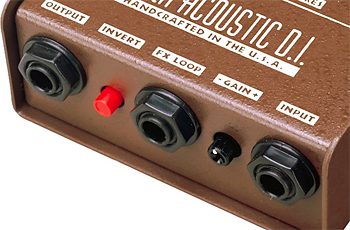 The Invert switch is used to change the polarity (phase) of the signal. The Phase affects the way the guitar top is pressurized by the loudspeakers. With the two signals out of phase with each other, low-end feedback is minimized.
The Invert switch is used to change the polarity (phase) of the signal. The Phase affects the way the guitar top is pressurized by the loudspeakers. With the two signals out of phase with each other, low-end feedback is minimized.
The L.R. Baggs Para Acoustic D.I. is powered by a nine-volt battery or can be powered by phantom power through the XLR cable from your mixing board – very cool!
Usability
The Para Acoustic D.I is housed in a rugged metal casing with raised plastic control knobs, and its operation is extremely user-friendly. As with all EQ/tonal based sound sculptors, you really need to experiment with the settings to obtain the desired result.
The unit is laid out in a very accessible manner. The control knobs are raised for easy accessibility and clearly marked using brown lettering within a white background block. The knobs themselves are black with white dot markers to identify the position of the controls.
As simple as it is, one of our favorite features was the nine-volt battery drawer. We’ve seen a lot of different access points for changing batteries including the screwdriver required set-up and slide-cover configurations. The Para Acoustic D.I. has a nifty pop-out battery drawer that makes battery changing as quick and simple as possible. No wires to connect – just insert the battery in the drawer and slide it into the unit.
For power monitoring, the unit is equipped with a battery status LED that remains illuminated when the unit is in use. Should the nine-volt battery decrease to six volts, the LED will begin to flash, and at five volts, the LED will stop flashing. In addition to battery power, the L.R. Baggs D.I. can also be powered by phantom power via the XLR output connection to a powered console.
Further, there was no need to remove the battery during the phantom powered operation. The L.R. Baggs Para Acoustic D.I. automatically disconnects from battery support when phantom power is provided, and the 48V LED illuminates to show that phantom power is engaged. The instant phantom power is no longer available the unit switches back to battery support.
All control features are accessible on the top of the L.R. Baggs with the exception of the Gain control and Invert switch located on the side of the unit.
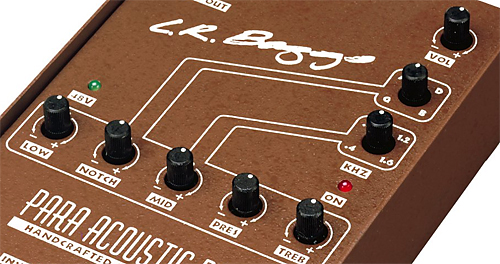 The Notch filter and Tune control knob were a little confusing at first glance – we had to refer to the owner’s manual for detailed explanation and clarification, but once we read up on the feature, it made perfect sense. The Notch control knob gives the user the ability to cut a specific frequency most likely resulting in feedback. The Tune knob labeled from the counter-clockwise position contains the letters G, A, D and B. These letters correspond to the actual notes on the guitar and help the user identify specific frequencies that may be resulting in feedback. For a more detailed explanation of frequencies, G=98Hz; A=110Hz; D=150Hz and B=247Hz. The user may also select any frequencies in-between each note marked for tweaking.
The Notch filter and Tune control knob were a little confusing at first glance – we had to refer to the owner’s manual for detailed explanation and clarification, but once we read up on the feature, it made perfect sense. The Notch control knob gives the user the ability to cut a specific frequency most likely resulting in feedback. The Tune knob labeled from the counter-clockwise position contains the letters G, A, D and B. These letters correspond to the actual notes on the guitar and help the user identify specific frequencies that may be resulting in feedback. For a more detailed explanation of frequencies, G=98Hz; A=110Hz; D=150Hz and B=247Hz. The user may also select any frequencies in-between each note marked for tweaking.
By first sounding each note on the guitar, determine which note produces the most feedback. Once a problem note/frequency is determined, use the Tune control knob to select the corresponding note (G, A, D, or B) and back down the Notch control knob until the feedback is eliminated. This control proved to be extremely effective in cutting out feedback.
The Midrange control and sweepable Tune knob gave us the ability, like most amplifiers, to control the warmth and nasal characteristics of the tonal spectrum found between 400Hz and 1.6kHz. Unlike the Tune knob for the Midrange control, this knob is actually marked with specific frequency ranges. Upon pinpointing a specific frequency to adjust using the Tune knob, a cut via the Midrange knob was very effective for removing the offending (or unwanted) frequency.
Sound
The L.R. Baggs Para Acoustic D.I. provides excellent tonal control as well as sound quality enhancement for any acoustic guitar setup. Mr. Clean doesn’t have anything over this direct box! The Para Acoustic D.I. provided a well-balanced spectrum of tone without any added distortion or hiss. It was extremely studio-quality clean.
The Bass control knob provided a very desirable response. It gave us the ability to add bass response to achieve a very clear yet round warm tone. In addition, the Bass control allowed us to roll off bass frequency in the event feedback was evident. In conjunction with the Notch Filter we were able to eliminate the frequency responsible for the low-end feedback while still maintaining a desired low end response.
The Treble control provided that extra clear high-end mostly referred to as “air.” Though a very basic tone control, the effect of the air factor was very noticeable and provided the clarity we were looking for.
Within the function of the Presence and Treble controls, we were able to obtain as much “air” or high-end definition as desired.
We tested the L.R. Bags Para Acoustic D.I. a number of different ways. One configuration involved using an Ernie Ball Music Man JP6 equipped with a Piezo pickup plugged into the Para Acoustic D.I. and then into a Mackie mixer/PA system. Once dialed in, we found the sound to be so comparable to that of an authentic acoustic guitar that it was almost unbelievable (in a truly believable sort of way) – the tone was as lush and round as could be, and didn’t compare to bypassing the D.I. and connecting the guitar’s Piezo output directly to the mixer.
The second test was completed in the same manner, but using a Takamine acoustic guitar with an onboard preamp/pickup configuration. As with any acoustic, they all have different characteristics, but the L.R. Baggs Para Acoustic D.I. provided all the necessary functions to obtain an excellent sound. Using the Notch control really helped dial in (and eliminate) the most prominent feedback frequency and back it out of the mix. The Invert control also helped un-pressurize the top of the guitar to help eliminate feedback as well. The Low frequency control brought out the full sound of the body and wood tone. With the addition of Presence and Treble controls, the amplified tone we obtained was warm, bright and crisp.
Because a lot of players still opt for the use of a removable sound-hole pickup, we tested the Para Acoustic D.I. using our cheapest humbucking acoustic sound-hole pickup (in our not-so-cheap Martin acoustic). The most common problem with sound-hole pickups is the lack of feedback control. Even with the Notch control and Invert control features, we were not able to totally minimize and control the feedback without changing the tonal character of the sound. Through no fault of the L.R. Baggs Para Acoustic D.I., we found this less-exciting tone control and sound to be a limitation of the older pickup technology.
Documentation and Product Support
The L.R. Baggs Para Acoustic D.I comes with a very descriptive User’s Guide. The document provides detailed descriptions of each control feature as well as guidance on how to use each control. L.R. Baggs even provides suggested Gain settings based upon the type of pickup used and the length of the cable connecting the guitar to the Para Acoustic D.I.
This unit comes with a limited one-year warranty.
Price
The L.R. Baggs Para Acoustic D.I. (MSRP $229) can be found online for approximately $160. We feel the L.R. Baggs Para Acoustic D.I. provides an excellent value for the price.
Contact Information
L.R. Baggs
www.lrbaggs.com
| Evaluation Short-List |
|

